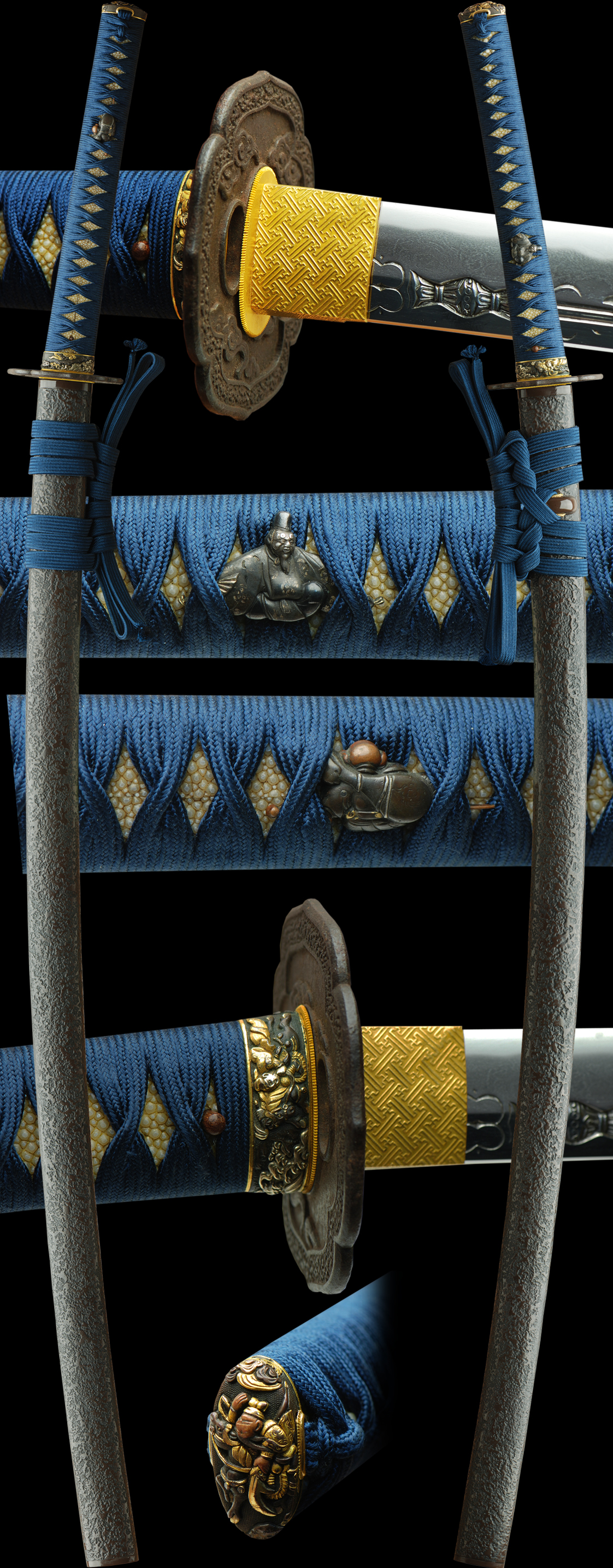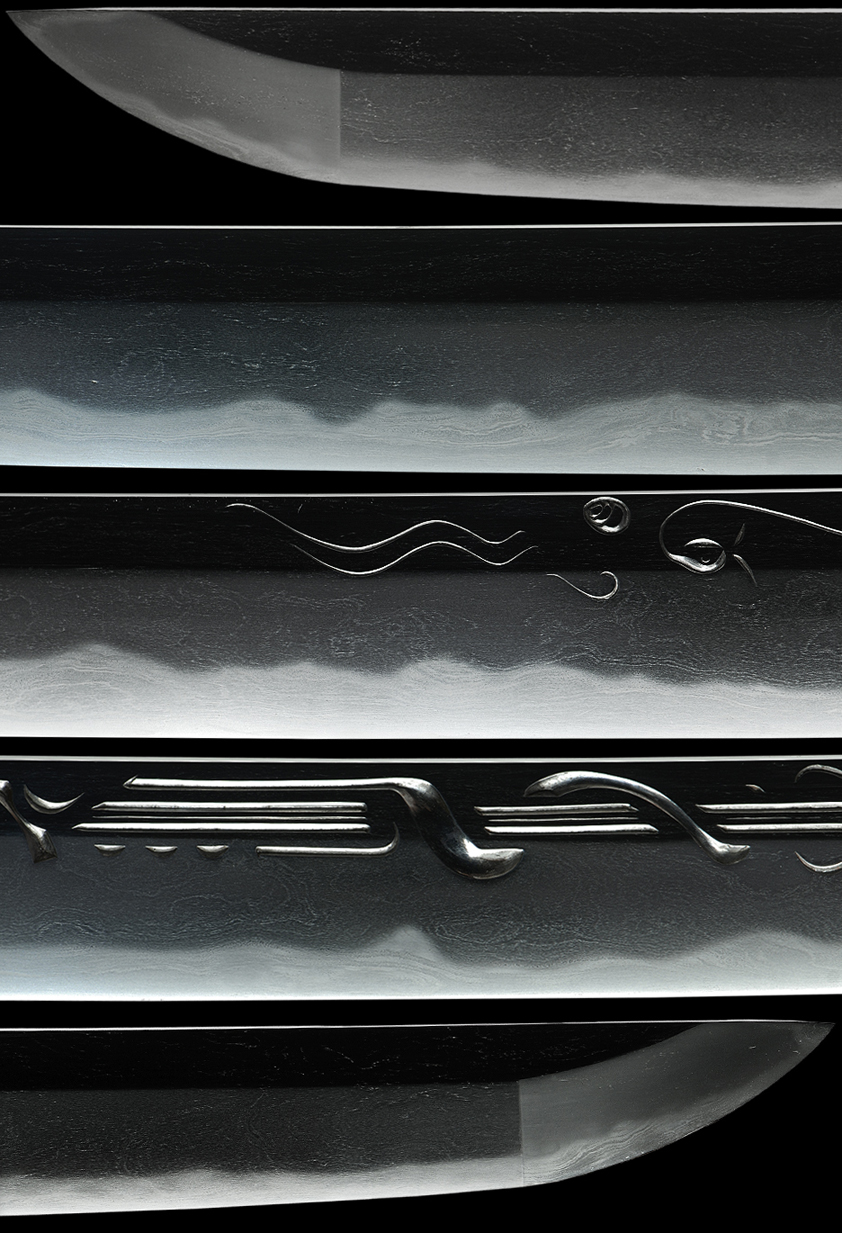This blade is spectacular in its size and girth. At just over 31″ it is a site to behold and view. Koto era swords of this length are very uncommon and desirable. The hamon represents the best of this style by this smith based in a gunome midare with choji. It is laced with sunagashi, kinsuji and nie. The hada has a depth seldom seen on swords of this era. There is a deep, rich looking hada. The blade is loaded with chikei, ji-nie all on an elegantly woven pattern of Masame, itame and mokume grain pattern blending for the perfect backdrop of this gorgeous hamon. The pictures cannot show the complete beauty of this steel and must be appreciated in hand. The polish is a spectacular sashikomi style which gives a crystal clear view of all the swords unique attributes. The boshi is ko-maru with hakikake. The blade is O-suriage but appears ubu with 2 mekugi-ana. It is beautifully carved with an exceptional horimon of dragon on sword and sohi with bonji on other side.
The koshirae is a spectacular accompaniment to the sword. The fittings of samurai in battle are also in a spectacular pristine condition. The Tsuka-ito and Sageo are a rich blue and the lacquer is finished in a stone texture of brown highlights which perfectly accompanies the horimono of the blade. There is a stylized mokko-gata and arabesque tsuba in iron with a deep motif engraved Cloud design. There are Buddhist figures sitting front to back in meditative postures for menuki. The Same has a beautifully aged patina.This beautiful koshirae is adorned with matching royal blue sageo and tsuka ito and fully restored.
The tsuba depicts a clouds setting engraved with designs at the outer part of the tsuba nearer the rim. The fuchi kashira are of samurai on horseback with weapons. The saya has a deep rich texture to it and adds greatly to the overall appearance of the koshirai/mounts. The habaki and seppa are gold foiled in a Buddhist svatzi motif in a rich golden finish with matching gold washed seppa and shitadome.This blade is fully polished with shirasaya, tsunagi for mounts and papered.
FUJISHIRO:
HIROTSUGU SÔSHÛ [BUNMEI 1469 SAGAMI] SUEKOTÔ JÔSAKU
This name was revived along with Masahiro and Sukehiro, and the Hirotsugu works in existence began with this smith. His works include katana and tantô, hamon is midareba, gonome choji, and there are also horimono.
Signatures: SÔSHÛ JÛ HIROTSUGU SAKU
HIROTSUGU
Page 508
Plate I: SÔSHÛ JÛ HIROTSUGU SAKU
HIROTSUGU SÔSHÛ [EISHÔ 1504 SAGAMI] SUEKOTÔ JÔSAKU
He is the son of Bunmei Hirotsugu, there are works from Meiô to Eishô. The Bunmei Hirotsugu is also viewed as the same person. Hamon is gonome choji and suguba nioi shimari. Horimono of bonji and suken are also seen.
Signatures: HIROTSUGU
SÔSHÛ JÛ HIROTSUGU SAKU
Plate II: SÔSHÛ JÛ HIROTSUGU SAKU
Plate III: SÔSHÛ JÛ HIROTSUGU SAKU
- Mei: Mumei with attribution to Soshu Hirotsugu
- Date: Koto (1500’s)
- Nagasa: 31-1/8 inches
- Sori: 16.0 mm
- Width at the ha-machi: 39.2 mm
- Width at the yokote: 21.2 mm
- Thickness at the mune-machi: 7.21 mm
- Construction: Shinogi zukuri
- Mune: Iori
- Nakago: O-suriage
- Kitae: Itame
- Hamon: Gunome
- Boshi: Ko-Maru
- Condition: Excellent Sashikomi polish
It was during the Meio period that many swordsmiths moved to the Odawara region. These smiths all enjoyed the patronage of the Lord Hojo Soun and formed the Odawara soshu tradition or school.
Soshu Hirotsugu moved to Sagami Province in the late Muromachi period
and became one of the leading sword smiths of the soshu school.
Soshu Hirotsugu first generation was successful during the Bunmei period(Year1469 to Year 1486).
In Eisho period, the second generation produces Soshu den blades in Sagami.
In the past, many swordsmiths flourished from the first generation HIromitsu of the Nanbokuchou period.
It is not known why it is o-suriage but in the Bunmei period, the nakago becomes long and enticing. His large broad
pieces were popular among the sword collectors noted for their elegant and soft feeling.
There are many works found with the best engravings and this sword has a fine and beautiful example of a “So No Kurikara” or dragon winding around a sword which is a highly simplified and sophisticated version of this type of horimono at the same time.
.
Soshu Hirotsugu made many brilliant works and is highly prized by the collector.
This sword fully represents the traits of the Soshu school work which included the fine combination of a luxurious Jigane and a Hamon of incredible beaury.
This is a piece that would be considered the best of the Muramachi Soshu Jyoko work.
Email us if your interested in this item and remember to include the order number for this item: fss-755.
This sword has recently passed shinsa. This is the work sheet, the oficial papers will take a few month to be made and sent from Japan. These papers will be forwarded to the new owner when this sword sells.
PLEASE NOTE THAT 95% OF SWORDS THAT PASSED AT THIS SHINSA SCORD 70 POINTS OR LESS, VERY FEW SCORD OVER 70 POINTS. THIS SWORD WAS AWARDED 7I POINTS ATTESTING TO ITS QUALITY.
For Sale

























